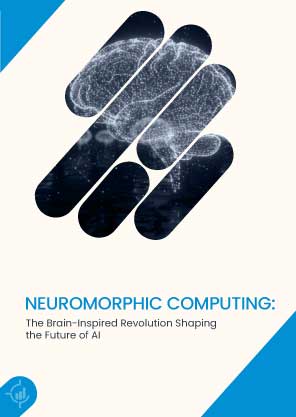or call: +1 (845) 347-8894

or call: +1 (845) 347-8894

Imagine running AI that thinks more like your top strategist than your fastest server. That’s the promise of neuromorphic computing. This emerging, brain-inspired technology is reshaping how enterprises build, scale, and power AI
It represents a rare chance to leap ahead before the rest of the market catches on. As compute demands explode and efficiency pressures grow, neuromorphic computing is becoming the quiet force rewriting the future of intelligent systems and the future of business.
The adoption of neuromorphic computing has direct relevance to business outcomes. First, as AI workloads grow – especially on the edge traditional hardware is straining under demands for speed, power efficiency, and real-time response. Second, recent market indicators underscore the urgency: global spending on edge computing is projected at around US $261 billion in 2025.
Meanwhile, the global neuromorphic computing market is estimated at about US $8.36 billion in 2025. For enterprise leaders, those numbers signal an inflection point: the infrastructure underpinning AI is shifting. Embedding neuromorphic strategies means not just keeping pace but gaining a competitive advantage.
1. Energy efficiency and cost savings – By mimicking biological neural networks, neuromorphic systems conserve power and reduce wasted cycles. Lower energy means smaller cooling and infrastructure bills. Leadership teams can translate that into improved margins and lower total cost of ownership.
2. Real-time performance at the edge – From autonomous vehicles to industrial robotics, decision windows are shrinking. Neuromorphic architectures excel in low-latency, on-device intelligence – ideal where cloud dependence isn’t viable. For business leaders, this means faster insights and improved responsiveness across operations.
3. Adaptability and new use-cases – Neuromorphic systems are built for adaptability – learning from sparse, unstructured data and evolving. This opens the door to novel business models: smart sensors, autonomous process controls, next-gen personalization in customer engagements.
4. Future-proofing your AI architecture – With the market growing robustly, early adopters gain leverage. The neuromorphic computing market is projected to expand at a compound annual growth rate (CAGR) of roughly 21% + from 2025 onward. Embedding this capability now yields first-mover advantage and protects against being locked into legacy hardware.
To translate this technology into business impact, executives should consider three strategic steps:
Identify where neuromorphic computing offers distinct value: ultra-low latency, edge computing, and energy-constrained environments. For example, sensor networks in manufacturing – or real-time analytics in logistics – may benefit disproportionately.
Supporting brain-inspired computing requires an infrastructure rethink. As one analysis notes: “the edge landscape in 2025 is characterised by both opportunity and urgency.” Alongside technology investment, ensure talent with a hybrid neuroscience-AI-hardware understanding is in place.
Given that neuromorphic platforms are still maturing, build strategic partnerships – academic research, hardware vendors, and edge specialists. A pilot approach allows you to prove value before large-scale roll-out.
Stepping into neuromorphic computing isn’t about chasing the next shiny trend. It’s about making thoughtful, future-focused decisions that align with your organisation’s long-term goals.
Leaders should recognise that the ecosystem is still evolving, teams may need new skills, and existing systems might require rethinking. But these challenges aren’t roadblocks – they are stepping stones. With the right mindset and the right partners, organisations can learn, adapt, and grow at a pace that feels both ambitious and manageable.
At the end of the day, neuromorphic computing isn’t just a hardware upgrade. It’s a mindset shift. It encourages leaders to think beyond incremental improvements and imagine what AI could do if it operated more like the human brain – fast, efficient, and adaptive.
For C-level executives, this is a chance to shape how the next decade of intelligent systems is built. It’s an opportunity to lead with curiosity, invest with intention, and unlock business value long before the competition realizes what’s happening.
Q1: How does neuromorphic computing differ from traditional AI hardware?
Neuromorphic computing uses spiking neural networks and integrates memory and compute in one; conventional AI hardware separates them and uses continuous data flows.
Q2: Where are real-world applications emerging now?
Applications span real-time sensory processing, robotics, edge diagnostics, adaptive control, and logistics anomaly detection.
Q3: What size is the market in 2025?
Estimates show roughly US $8.36 billion for the neuromorphic computing market in 2025.
Q4: What is the link between neuromorphic computing and business growth?
By enabling faster, more energy-efficient, adaptive AI, neuromorphic systems help deliver cost savings, operational agility, and new business models – critical levers for growth at the C-suite level.
Q6: How can companies start experimenting with neuromorphic computing in a practical way?
Most organisations begin with small, low-risk pilots focused on edge workloads or energy-intensive AI tasks.
To participate in our interviews, please write to our IntentTech Media Room at info@intentamplify.com




